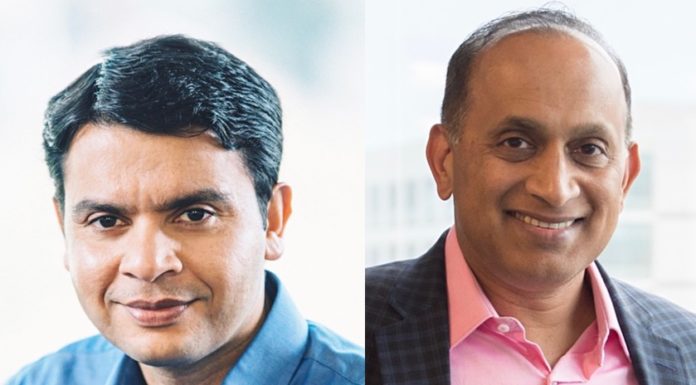Eight months after filing for its IPO, data protection and management company Cohesity has hired its first external CEO: Sanjay Poonen, with founding CEO Mohit Aron transitioning to CTO and Product Officer. We had the opportunity to meet these two execs at Cohesity’s San Jose HQ and discuss Poonen’s ambitions for the company.
We’ll structure this interview in two parts, with the first focusing on Mohit Aron, and the second on Sanjay Poonen and his thoughts.

Cohesity presents itself as a data management company. Blocks & Files suggested that Cohesity doesn’t manage primary data, data in databases, transaction data, data in data lakes, or data warehouses. It primarily manages data that’s been protected by Cohesity. The bulk of an enterprise’s data does not appear to be covered by Cohesity, so how can it call itself a data management company?
Founding and now ex-CEO Mohit Aron said: “Cohesity is a data management company, and I think data management does not equal backups. We actually do way more than backups. In fact, our mission – the mission of the company – was that there are too many silos in IT infrastructure. One of the silos is backup.”
There are other silos like managing files and objects, test and development, and silos on doing analytics. Cohesity, Aron said, brings all these together. “We do analytics, we can do protection against ransomware. And security. We store production objects, we do handle production data for many of our customers, they store their files and objects on us.”
Aron said: “We have over 700 customers, I believe, that … store their files and objects on us … something around 25 to 30 percent of our customers use us for more than one use case. I think, from a business point of view, yes, we may have started primarily as backup … but we are a data management company.”
The iPhone analogy
He compared Cohesity to a smartphone. “A smartphone started off by being a telephone. But beyond that, it’s also a GPS. It’s also a camera. It’s also a flashlight, it’s also a music player. So … if you buy a smartphone, you’re probably not buying a camera … Some people may find some value in those products still and still may buy them, but by and large [they don’t].”
Some companies may still buy independent filers, object storage systems, and so forth, but many will use the ones that come with Cohesity – in the same way they use smartphone apps, built on and integrated with the smartphone platform.
Therefore, Aron said, “We are a data management platform. And there are some things we do today to address the $25 billion TAM. And as and when we innovate, that can possibly increase to a much bigger TAM, right? So there are possibly things that the world out there does to the data that we may not be doing today. But that doesn’t change the fact that we are still a data management platform. Nobody can do everything. You know, by by your argument, nobody can be called the data management company.”
He pointed out that the smartphone only had a handful of apps when it was introduced. Now it has millions. “So I would say the same thing about us – we have barely scratched the surface of what we can do.”
He said some companies “may call themselves data management because they do one thing. But the point is they don’t have a platform for doing anything more … I think it’s all about being a data management platform, which may start off by doing a few things with data. But over time, it’s been architected to do more things so that you don’t have to keep building silos.”
He is a strong believer in an ecosystem, in company partnerships. And Cohesity has a marketplace, launched in March 2019, from which customers are able to download apps and run those apps integrated with the Cohesity platform. For example, Cohesity partners with Model9 to do mainframe backups, and Model9 is in its marketplace.
Aron says that in order to have an app marketplace, you need to be a software platform on which you can run third-party software via APIs. Cohesity sees most of its data management and protection competitors have built products, architected them, as just a place to store bits and bytes. In contrast, Cohesity architects its software with the assumption that it’s going to be a general purpose platform on which customers can run other software.
Aron said: “It’s not just a dumb place where you put the data. It also is a place where you want to compute. And it’s not just our compute, it’s also compute from third parties.”
We checked. There are 26 apps available in this marketplace, 19 of which have been developed by Cohesity. That means getting on for three-and-a-half years after its launch, Cohesity has seven apps available from third parties and the ecosystem is fairly small.
Cohesity has a land-and-expand strategy. Sell to new customers for new workloads and/or by competitive takeout and, once present, expand the applicability and use of its software platform. Aron said one big financial customer moved from seven different backup products to just using Cohesity. Another a big financial customer had 75 different islands of Data Domain systems that they had to manage independently. Now they use Cohesity instead.
Having set the scene, part two of this interview will turn to Sanjay Poonen and how he intends to grow the company.








